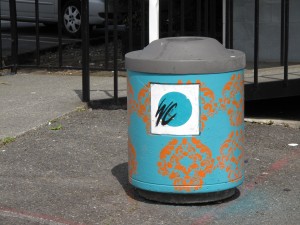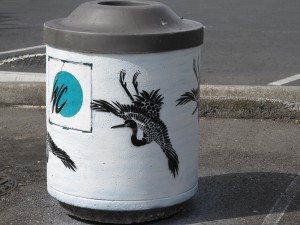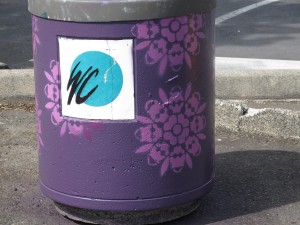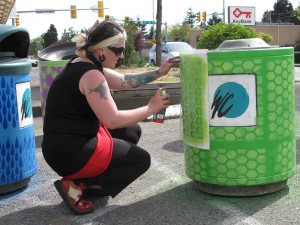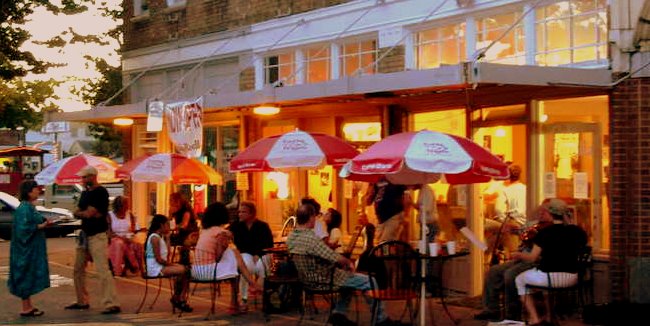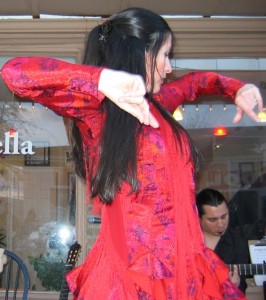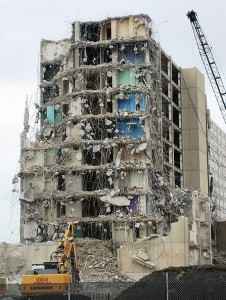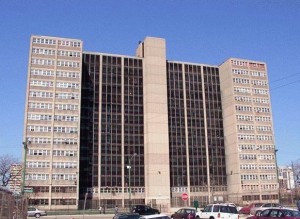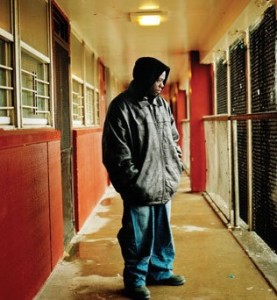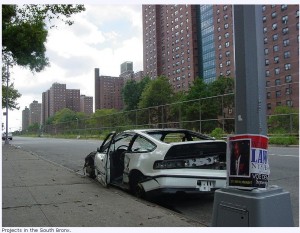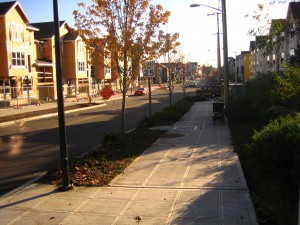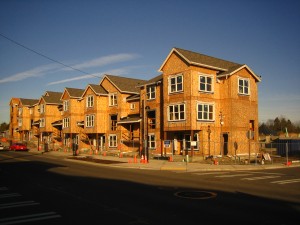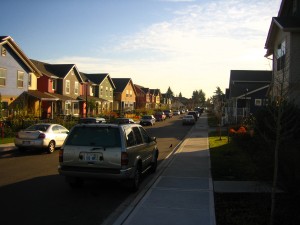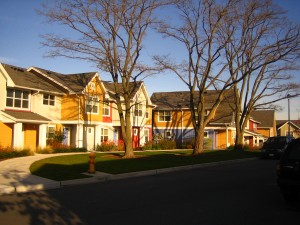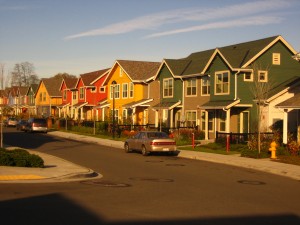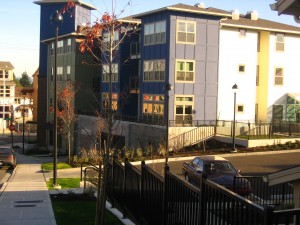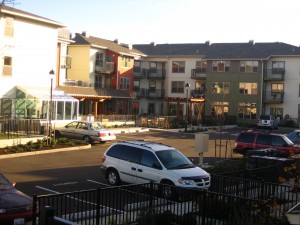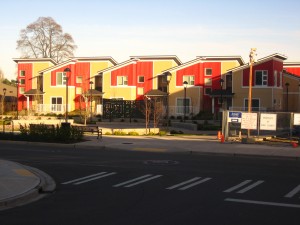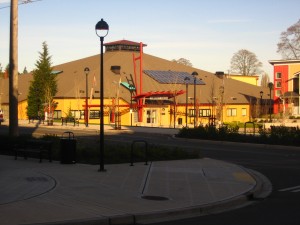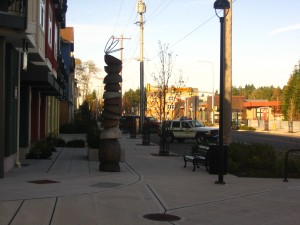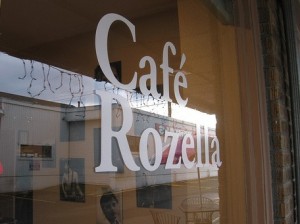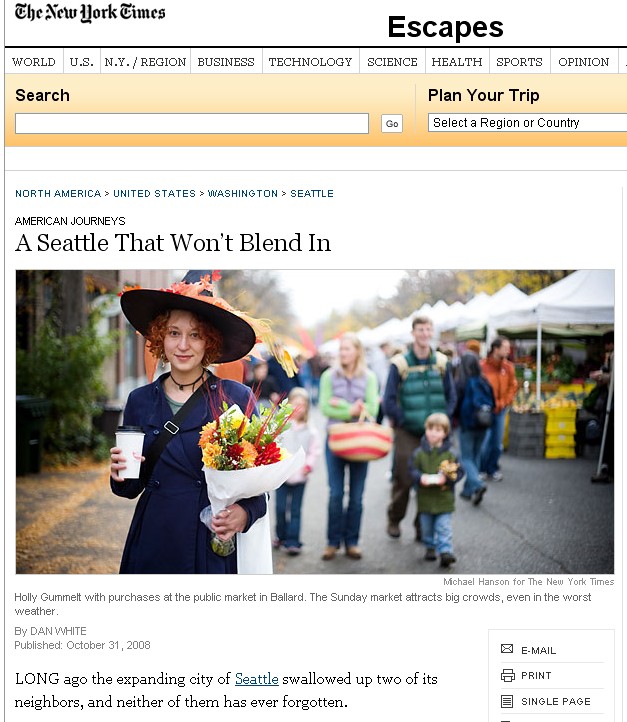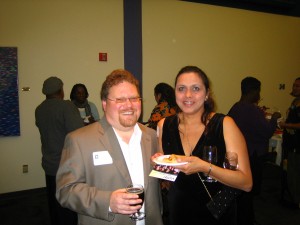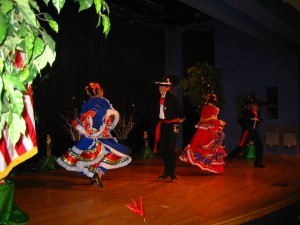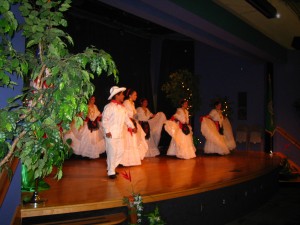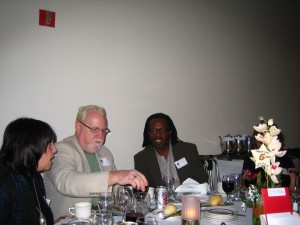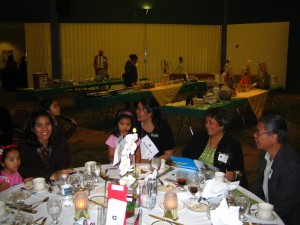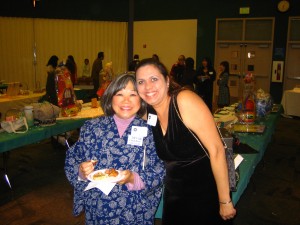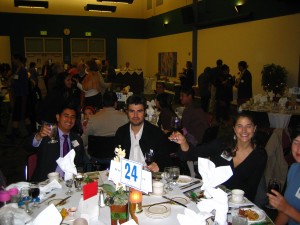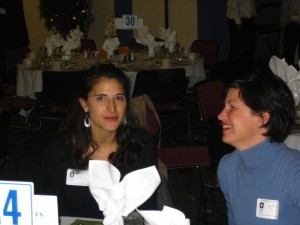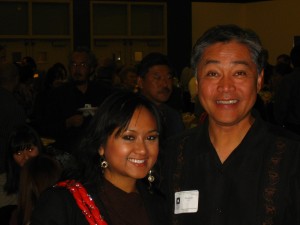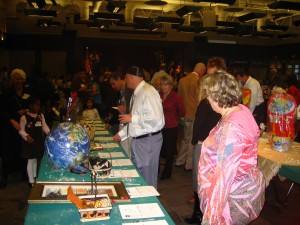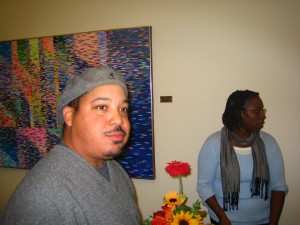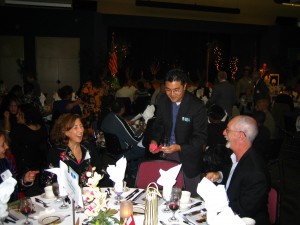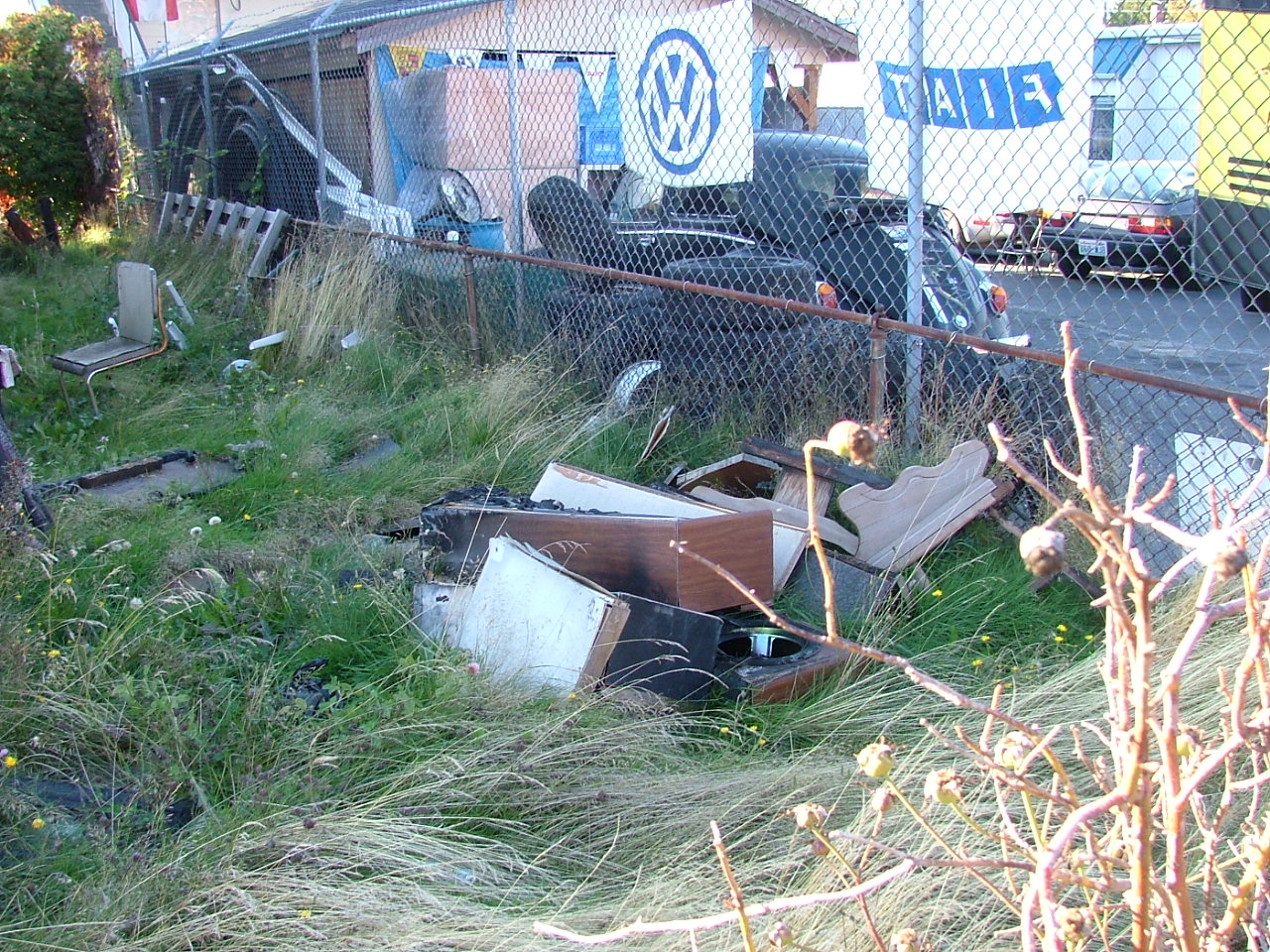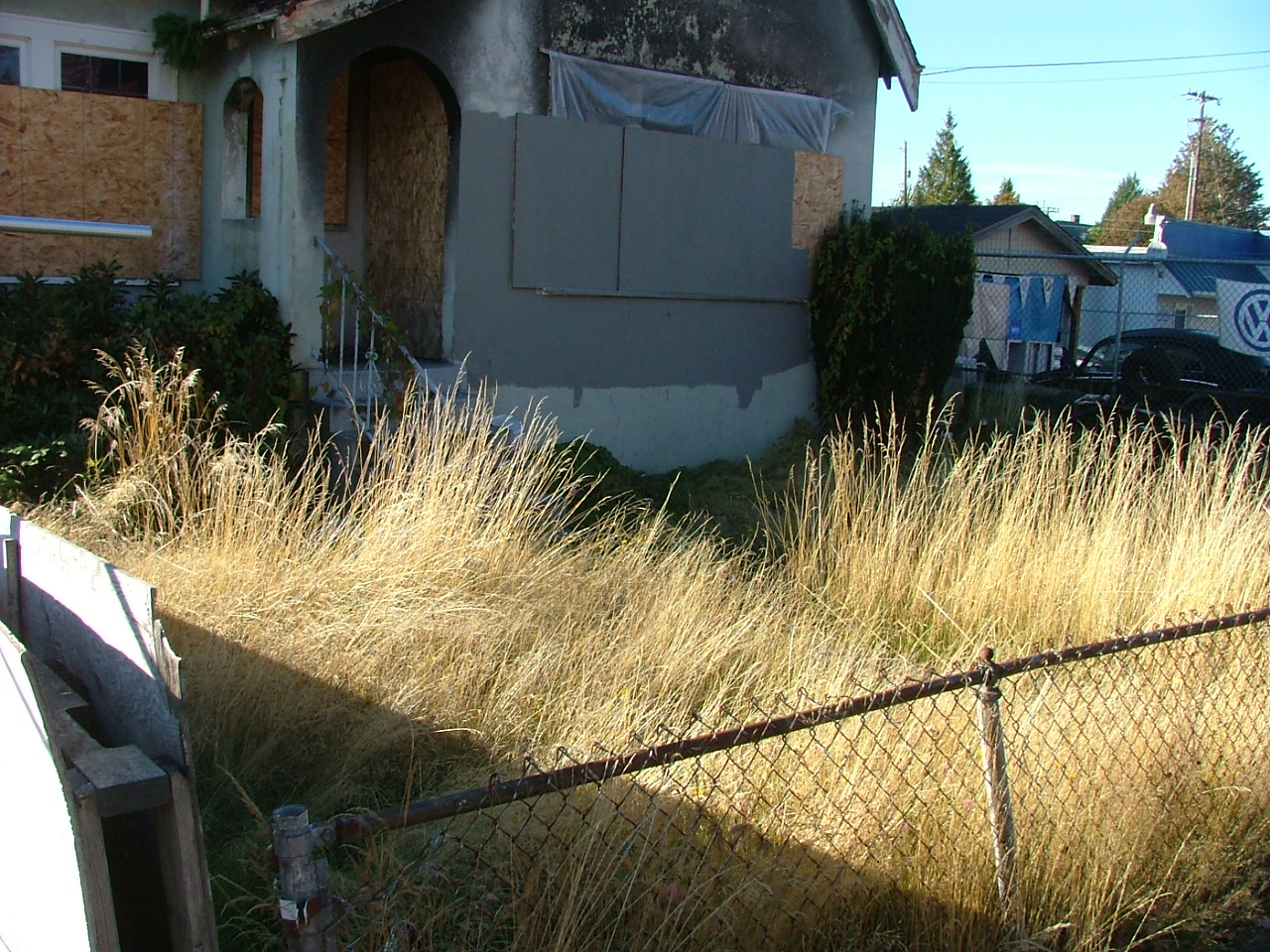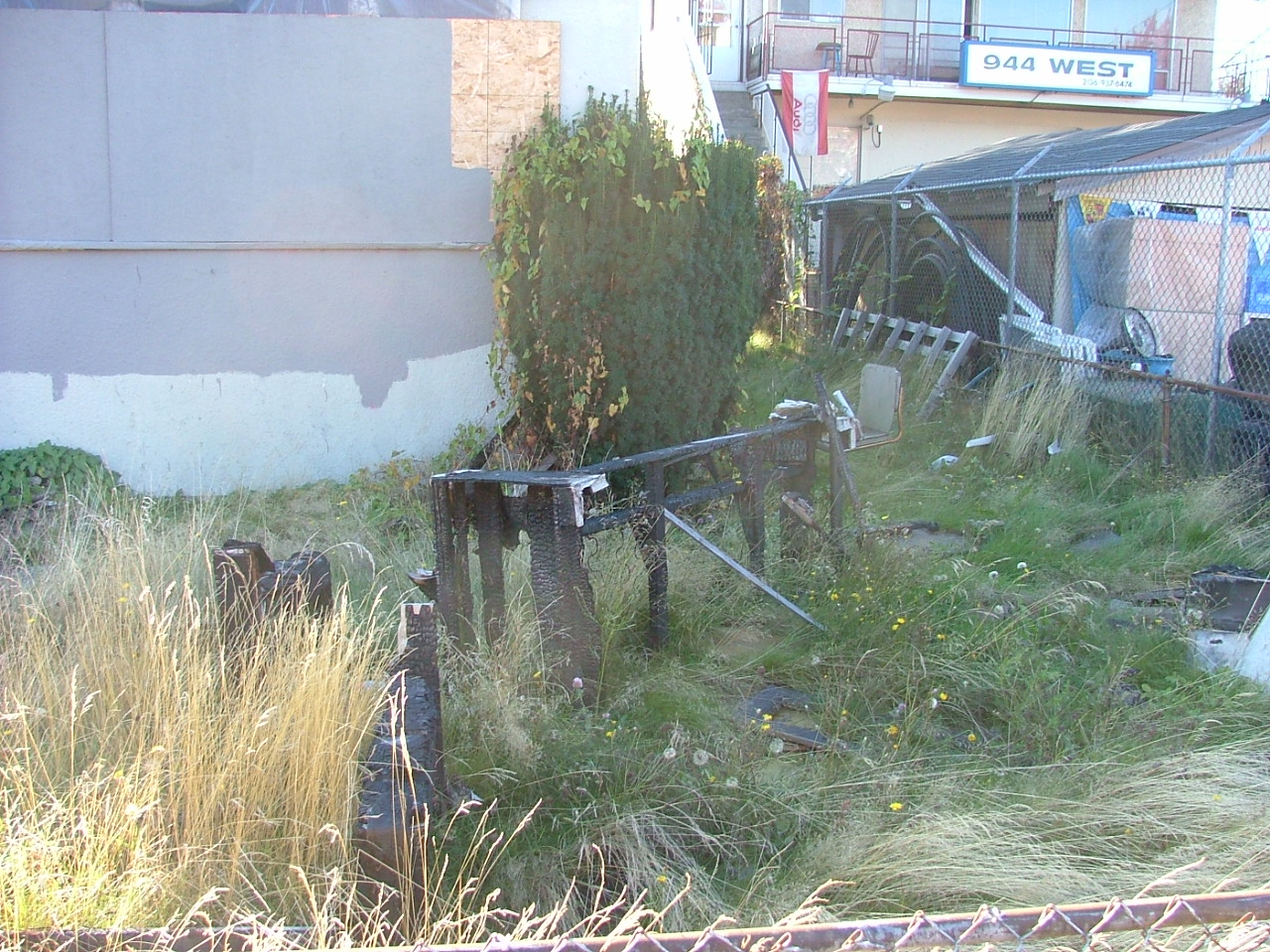Dig these cool binister designs by Kim McCarthy.
More White Center Spring Clean Photos
May 17th, 2009 Ricardo Posted in Arts, Development, White Center 6 Comments »
White Center for the Arts Open Studio Tour
May 14th, 2009 Ricardo Posted in Arts, Cultural Center, Development, White Center Comments Off on White Center for the Arts Open Studio Tour
Once again, it is time for the
White Center for the Arts Open Studio Tour
This coming Saturday, May 16th, 2009 5 PM until 10 PM
Please join us as we present eight artists’ new work.
A wine and cheese event.
White Center for the Arts Building
9639 16th Ave SW
White Center, WA
206-306-6230 for additional information
White Center Spring Clean Up Coming May 16th
April 24th, 2009 Ricardo Posted in Development, Graffiti, White Center Comments Off on White Center Spring Clean Up Coming May 16th
About that $6 million deal … It’s for White Center Square
April 1st, 2009 Tracy Posted in Development, King County, White Center news 4 Comments »
View Larger Map
Several White Center Now commenters asked questions following our publishing the other day of the King County Council’s news release announcing a $6 million financing deal for a “retail plaza … near Greenbridge.” What’s the project, and what’s “White Center Investment Fund LLC”? they asked. Alcina noted that the state corporation files include no such entity. We put the question to King County Council Chair Dow Constantine‘s office, and James Bush explains:
“White Center Investment Fund LLC” is an entity set up for this loan by U.S. Bank. It’s a Delaware limited liability corporation, as are many of the local LLCs set up for development purposes. In this sort of federal tax credit arrangement the money moves around from entity to entity, but where it will end up is as a loan to Vongs LLC, a corporation owned by the Vong family. They have an Asian grocery store in White Center which will move into a much larger space in this project when it is completed.
The White Center Square site is at SW 100th/14th SW (Google Street View, above). The project’s total cost is expected to be around $10 million. Here’s the ordinance the council passed; we had spoken with the company working on the project recently, and they said they’re hoping to break ground around the end of this month.
ADDED WEDNESDAY NIGHT: KING 5 TV news was in White Center today to do a story about the project and the area’s revitalization in general (what? no Rozella/Full Tilt interviews?); see it here.
Microfinance as a way to develop White Center
March 30th, 2009 Ricardo Posted in Businesses, Development, Economy, Jobs, White Center 1 Comment »
Most people are aware that the greatest impediment to the start and development of the business is lack of capital. Tradtionally, banks only lend money to people who already have money. This makes it extremely difficult for would-be entrepreneurs to start a business — even one that is desperately needed. One solution to this quandry is the pooling of resources by a community to assist its members with the initial loan that gives them entry. The Asian and Latino communities already have models of this practice, the latter known as Tanda. Variants of this practice are known broadly as microfinance.
Microfinance refers to the provision of financial services to poor or low-income clients, including consumers and the self-employed.[1] The term also refers to the practice of sustainably delivering those services. Microcredit (or loans to poor microenterprises) should not be confused with microfinance, which addresses a full range of banking needs for poor people.[2]
More broadly, it refers to a movement that envisions “a world in which as many poor and near-poor households as possible have permanent access to an appropriate range of high quality financial services, including not just credit but also savings, insurance, and fund transfers.”[3] Those who promote microfinance generally believe that such access will help poor people out of poverty.
I would be curious to know if readers have any thoughts on this subject and how it might used as a tool to spur economic development and vitality in White Center and other areas.
Homeownership for the Community – Thursday, April 9th @ 6 p.m
March 25th, 2009 Ricardo Posted in Development, Economy, housing, Real estate, White Center Comments Off on Homeownership for the Community – Thursday, April 9th @ 6 p.m
Homestead Community Land Trust (HCLT) will be holding a special Informational Session at the Greenbridge Library, 9720 8th Ave. S.W. on Thursday, April 9th from 6 to 7:30 p.m. for anyone interested in learning more about affordable homeownership opportunities.
Homestead is partnering with eligible homebuyers to create affordable homeownership in the White Center and Boulevard Park. How it works is the homebuyer selects a home that is FOR SALE and fits their needs and budget. They pay $100,000 less than the sales price, significantly reducing their monthly mortgage payment. In exchange for receiving the $100,000 –which does not have to be paid back – the homebuyer agrees that when they decide to sell, they will sell to another income eligible buyer at an affordable price. In this way, the community maintains a stock of affordable homes and the homebuyer passes on the affordability to the next buyer.
For example, a recent Community Land Trust homebuyer in White Center is paying $950/month as their housing payment for a 2 bedroom single family home with a large basement and detached garage. They have a stable monthly payment, have the opportunity to build equity, can live there as long as they want, and they receive the tax benefits of homeownership!
To qualify, you must a) be a first-time homebuyer b) earn less than 80% area median income for King County** c) have the ability to be approved for a home loan d) have a desire to live and own a home in the White Center/Boulevard Park community e) have 1% or $2500 to put towards the down payment.
Please help get the word out by encouraging eligible future homebuyers to attend the session. At the session we’ll provide:
- An overview of Community Land Trusts and our approach to homeownership
- A detailed view of Homestead’s Purchase Program for White Center/Boulevard Park
- Steps to getting started on the path to Homeownership
You can contact Laura Evans with any questions or to RSVP for the session.
Laura Evans
Homeownership Program Manager
Homestead Community Land Trust
2524 16th Ave. S. Suite 300
Seattle WA 98144
ph: 206 323 1227 ext. 111
fax: 206 588 0253
Interesting Article on Kindred Cafe in NYC
March 16th, 2009 Ricardo Posted in Businesses, cafe rozella, Development, Economy, White Center Comments Off on Interesting Article on Kindred Cafe in NYC
From the New York Times, a story of a cafe, not unlike Cafe Rozella:
Vox Pop was “kind of placing a bet on an emerging neighborhood” when it opened, said Sander Hicks, an author and political activist who started Vox Pop with Holley Anderson, his girlfriend at the time. He also published a free newspaper, The New York Megaphone, and was elected president of the merchants’ association. “We always used to say, it’s about smart growth, not gentrification,” Mr. Hicks said.
How different it was just four and a half years ago, when Vox Pop opened. “This was all 99-cent stores and video stores, socioeconomically challenged, surrounded by lovely Victorian houses that people have lived in forever,” Ms. Ryan said.
King County Food and Fitness Initiative needs your feedback.
March 13th, 2009 Ricardo Posted in Development, Food, White Center Comments Off on King County Food and Fitness Initiative needs your feedback.
Please contact David Daw at David@wccda.org for a copy of the survey.
King County Food & Fitness Initiative is working to transform the food environment in our area so everyone can have access to affordable, healthy, locally grown food. By completing this survey you will be helping the White Center Food & Fitness Advisory Council select priorities to create a plan and implement changes around food systems in White Center.
*Please return survey by Monday March 23rd to: David Daw- Neighborhood Revitalization Program Manager, White Center Community Development Association, 1615 SW Cambridge Street, Seattle WA 98106 -Phone 206-694-1082 -Email: David@wccda.org.
Viaduct to be replaced by a tunnel
January 13th, 2009 Ricardo Posted in Development, Transportation, White Center news 1 Comment »

That’s a WSDOT graphic of a cross-section from the proposed tunnel; here’s the official news release from the governor’s office:
Gov. Chris Gregoire, King County Executive Ron Sims, Seattle Mayor Greg Nickels, and Port of Seattle Chief Executive Officer Tay Yoshitani today announced their agreement to replace the Alaskan Way Viaduct with a deep bored tunnel under downtown Seattle. The plan also includes investment in improved bus service, east-west city streets, a new seawall, relocated utilities, and an upgraded waterfront.
The agreement is the result of a year-long study of solutions for replacing the central section of the Alaskan Way Viaduct. Thousands of hours of technical analysis, public meetings, and letters and emails from the public, interest groups, and local jurisdictions were considered.
“Building a deep bored tunnel will support a strong economy today and in the future,” Gregoire said. “This decision will improve public safety, help ensure Seattle is a 21st Century international city, and generate thousands of new family-wage jobs in the Puget Sound region.”
The bored tunnel will be approximately two miles long and carry four lanes of traffic. Drivers will bypass downtown by entering the tunnel near the sports stadiums in the south and connect to SR 99 north of the existing Battery Street Tunnel.
The total cost of the investments is $4.24 billion. The state’s commitment of $2.81 billion will be used for a new state route 99 corridor from the sports stadiums to South Lake Union in a bored tunnel, and restoring land under the existing viaduct to a four-lane surface street.
“There are pivotal moments when great cities make history,” said Nickels. “Today, we come together with a plan that creates more transit. We ensure that our city remains economically competitive. And we reclaim our destiny as a true waterfront city—tearing down an elevated highway and re-connecting Seattle to Elliott Bay.”
The project costs for the city are $930 million to replace the central seawall and construct a waterfront promenade, relocate utilities, build a streetcar on First Avenue, and improve east-west streets. The county will seek new motor vehicle excise tax authorization from the legislature to fund over $190 million in transit capital and $15 million annually in operating expenses. Port CEO Tay Yoshitani will ask the Port Commission to consider a $300 million investment in the replacement of the south mile of the viaduct and a new east-west connection to the container terminals.
The agreement also includes federal funds toward the Spokane Street Viaduct and Mercer Street projects. These projects provide critical east-west connections for west side neighborhoods. Seattle’s waterfront will become a world-class destination when the viaduct is taken down and replaced with a four-lane surface street and open space. The central seawall will also be replaced.
Investments in transit will add 17,000 new riders to King County METRO buses. New service will be provided for west side neighborhoods that use the viaduct to go to downtown Seattle. A new streetcar will be built on First Avenue from Pioneer Square to Seattle Center.
“This agreement will improve our transportation system, improve our quality of life and make an historic shift in the way we view mobility in an age of global warming,” said Sims. “There are only four lanes in the bored tunnel and the plan includes a new stable source of transit funding that will help Metro make a vast increase in service, which will mean fewer cars on streets, less pollution and better traffic reliability for business and industry.”
The Port of Seattle serves as an international gateway for the region – bringing cargo in and sending Washington goods to the world,” said Yoshitani. “Our cargo, cruise, fishing and industrial facilities – and the thousands of jobs they support – need a transportation network that keeps people and goods moving.”
Construction of a bored tunnel will begin in 2011 and be open to drivers in 2015. Added transit service will begin next year, and the Spokane St. and Mercer St. projects will be completed by 2012. It is expected this proposal will establish 10,000 jobs in a ten year span.
Cafe Rozella Wants to Thank Our Wonderful Patrons
January 2nd, 2009 Ricardo Posted in Businesses, Development, White Center 1 Comment »
Cafe Rozella, White Center’s hub and coffee house, wants to thank all our wonderful patrons for making 2008 our best year and for electing Barack Obama, President of the U.S.
We look forward to better times. We cannot pass this opportunity to give thanks to: Mike the artist, mike the mechanic, mike the longshoreman, little mike and big mike, Cherrie, Onion, Eric the Swede, Joan, Carlos, Eduardo, Bill, Bill and Bill, Robert, Aileen, Laura, Jorge, Argelia, Paige, Eric, Vassily, Carmen, Flora, Sim, Chica, Jason, Anne, Jeremy, Austin, Ron, Gabrielle, Athena, Chad and Tracy, Andrew and Moe, Jessica, David, David and David, Ruth, Ringo, Paul, John, Maury, Rob, Gary, Gary and Marjorie, Jim, and everyone else who contributed to the wonderful community that is White Center and Cafe Rozella. We love you all. Truly.
Ron Sims on KUOW: Only Site for Seattle Jail is downtown next to present jail.
December 18th, 2008 Ricardo Posted in Development, Highland Park, Jail Sites, Politics, White Center, white center community safety coalition 2 Comments »
Ron Sims was on KUOW this morning. The issue of the jail’s location was raised by one caller and Sims was unequivocal in saying that, as far as the County goes, the only viable site is downtown, next to the present jail. This has been my position all along, for reasons which I will be glad to elaborate. But, the placement is not in the County’s hand, given that this is a regional jail for misdeamenants. The City of Seattle is the gorilla in the room on this one. I for one, do not comprehend why they would imbroil the city in litigation (and delay the construction) over the placement of a jail by inserting it into a neighborhood. Nobody would bat an eye, and everyone would be happier, if the jail was located downtown. I am not a big Sims fan, but he actually had a number of good ideas today. More importantly, he didn’t seem burned out, as he has in prior interviews.
PS: You can twitter Sims and he will add you to his twitter list, giving you direct access. Do you suppose we could convince Mayor Nickels to put us on his twitter list?
Greenbridge: The Failure of the Cabrini-Green Model of Public Housing and the Rise of the New Urbanism
November 28th, 2008 Ricardo Posted in Crime, Development, Greenbridge, Real estate, Sustainability, White Center, White Center news Comments Off on Greenbridge: The Failure of the Cabrini-Green Model of Public Housing and the Rise of the New Urbanism
The modern debate on urban housing policy takes as its starting point the post-World War II period when the country invested heavily in developing cities and its suburbs. An outgrowth of the New Deal was the belief that government should ameliorate the problem of housing for those unable to afford the cost of commercial or private housing. The response to the housing problem was a mixture of modernist thought, good intentions, government bureacracy, racial attitudes and local politics. While this subject is vast and would require tomes to fully comprehend it, we are here most concerned with the present moment in Seattle’s urban design and specifically the philosophy behind the Greenbridge Project.
The model against which much of the current thinking pivots is the Chicago Housing Authority and its notorious housing projects such as the Cabrini-Green projects. Witold Rybczynski is an architect and an astute observer, with a sweeping knowledge of urbanism and a very accessible writing style. I was introduced to Rybczynski’s writing when I was designing a home about 15 years ago and happened upon his meditative tome, “The Most Beautiful House in the World.” Rybczynski took Cabrini-Green as a paradigm for the development of urbanism for a 1993 article entitled, “Bauhaus blunders: architecture and public housing – 1950s public housing estates Cabrini-Green, Chicago, Illinois, US“:
Cabrini-Green is but one of the most notorious housing projects known for its drab and sterile concrete towers of festering poverty, rampant crime, trash-strewn stairwells and unmitigated squalor. Most of the towers are now being torn down.
The oldest housing on the site dates from 1941, not long after the Housing Act of 1937 that signaled the first involvement of the federal government in funding housing for what there then called the deserving poor. Frances Cabrini Homes was named after a soon-to-be-canonized Chicago nun, famous for her charitable work, and it was built on the site of a notorious Italian-American slum kown as Little Hell. The new housing consisted of almost 600 dwellings in two- and three-story brick buildings; the total area of the project was relatively small: sixteen acres. The unassuming architecture of these row homes–every dwelling had its own front door on the street–was not substantially different from the popular urban housing then being built by the private sector in the surrounding city. The brick facades even incorporated some decorative elements. The overall design, like that of most prewar public housing projects, is modest but unremarkable; it was taken for granted that poor people would prefer to live lie everyone else. (emphasis added)
Although Cabrini-Green has become synonymous with large government-run slums, they were not the largest or worst of its kind. Hunt D. Bradford has written a concise piece on the Robert Taylor Homes, a larger Chicago Housing project in piece entitled, “What went wrong with public housing in Chicago? A history of the Robert Taylor homes.”
The consensus it that the project tended to congregate poverty and stigmatize the residents. As articulated by Rybczynski:
Although Cabrini-Green occupies almost as much land as the Loop itself, it is not the biggest public housing project in Chicago–that dubious honor belongs to Robert Taylor Homes, said to be the largest public housing project in the world. But Cabrini-Green was the first of the big projects, and it did become a model for how municipal authorities would rehabilitate deteriorated inner-city real estate and provide large amounts of public housing. The solution–bulldoze existing houses and replace them with tall apartment slabs spaced far apart in open parkland (created byh closing off existing streets to make immense “supper-blocks”)–reflected the prevalent social and architectural thinking of the time. As Bauer pointed out, his was not how the majority of Americans really lived–or would choose to live–but the idealistic housing reformers felt that they knew best.
Architects and planners maintained that high-rise buildings were better because they occupied less land, and provided their occupants with sunlight and unobstructed views, but the Chicago Housing Authority was probably attracted to Modern architecture for the same reason that many commercial developers were partial to the designs of Mies van der Rohe–their cost. The truth is that standardized, stripped-down, and undecorated tall buildings can be erected quickly and inexpensively. It is also likely that the plain architecture suited the puritan view of many Americans–and certainly of the housing reformers–who felt that social housing should not be fancy. Soon, utilitarian high-rise apartment towers were accepted as the best solution for public housing.
High-rise slums
However, it was one thing to build apartment towers for the upper-middle-class, as Mies did, and quite another to adopt them as solutions for housing the poor. The well-off have doormen, janitors, repairmen, and baby-sitters; the poor have none of these things. Without restricted access, the lobbies and corridors were vandalized; without proper maintenance, elevators broke down, staircases became garbage dumps, roofs leaked, and broken windows remained unreplaced; without baby-sitters, single mothers were stranded in their apartments, and children roamed unsupervised sixteen floors below. In Cabrini-Green, there were problems with the design of the buildings: To save money, no private balconies or terraces were provided, access galleries and elevator lobbies were left open to the elements (in frigid Chicago!), and despite the lack of air-conditioning, the unshaded apartment windows of the tall buildings faced east and west.
Equally unsuccessful was the overall layout which dispensed with the familiar street and supplanted it with parkland, although what little landscaping there was quickly disappeared and was replaced by beaten dirt and asphalt parking lots. In any case, the open pedestrian spaces were problematic: windy, unappealing, and more crime-prone than conventional streets and sidewalks overlooked by individual homes. In the name of housing the poor, the well-meaning social reformers of the 1950s invented a new type of urbanism, quite foreign to any previous American ideal of city planning. It is hardly surprising that the projects acquired a social stigma. This, as well as crime, drugs, and poor management, explains why today one-third of the apartments at Cabrini-Green remain unoccupied [and are now being demolished].
The reaction to the failure of Cabrini-Green style projects was a return to a style termed, the New Urbanism. Again, Rybczynski:
Which brings us to the Greenbridge, High Point and Holly Park developments in Seattle. Each of these projects reflects completely the philosophy of the New Urbanism and the rejection of the Cabrini-Green model. The development are designed to mix inhabitants of different income levels. As well, the housing is of a human scale with an emphasis on street life, walkability and sustainability. Most critically, these developments aim to look like housing, that anyone, regardless of their station in life, would choose to live in.
Greenbridge and its Critics
November 23rd, 2008 Ricardo Posted in Development, Economy, Government, Neighborhoods, Safety, White Center, White Center Early Learning Initiative 9 Comments »
You have to hand it to Bush & Company, they were spot on when they proclaimed that the free market would most assuredly take care of such problems as affordable housing. Who could have known, a mere three years ago, with housing prices skyrocketing and rents pricing out most renters, that a social revolution was brewing. Social reformers and liberals cried out for government aid to build low income housing. Who knew that the mind behind Bush had a smashing plan for bringing down the cost of housing across the board and across the nation? Genius, pure genius! Drive the economy into the ditch and pretty soon you are picking up quarter-million dollar homes for $100K in Florida and California. Here in Seattle, rents have dropped dramatically and landlords are offering incentives to get their units occupied. Problem is no one has the money to snatch the cheap real estate. Ah, the magic of the free market at work.
What, you may well ask, does this have to do with the Greenbridge development? Greenbridge is more than a housing project, it is a master plan for the community. Greenbridge, and High Point, were developed with certain assumptions in mind.
The project, launched in 2001 with a grant from the federal Hope VI program — the same program that has contributed to the redevelopment of High Point and Holly Park — is supposed to include 1,025 living units. That’s a lot more housing than Park Lake held, but a lot less of it will be subsidized for the poor. The mix is supposed to include 300 rent-subsidized units, 353 workforce rental units, and 372 homes for sale at market rates. This represents a net loss of 269 rent-subsidized units. Instead of maintaining a large pocket of low-income housing in White Center, the county decided to disperse.
As well, the project was developed before the economy hit the squids and before the current real estate meltdown. Hence, the criticism that some of the economic assumptions underlying the project were wrong.
The King County Housing Authority built the first part of Greenbridge at the height of the real estate boom, when prices for everything were sky-high. The sale of lots for market-rate housing was supposed to reimburse the county some of the cost. By the time the housing authority offered its first relatively small group of market-rate lots for sale, the market had plunged. Only one developer bid on the land, at a price way lower than expected. Having bought high, the county felt it couldn’t afford to sell low. It retracted its request for proposals. For now, the single-family portion of Greenbridge is on hold until the market picks up.
As well, some readers of this blog have expressed concern that the early learning center is a lot of wasted money, destined more for monuments than for education. Needless to say, Greenbridge and its constituent parts have no shortage of critics. This is so, despite the very involved political process used to formulate its goals. Unlike private developments, the development Greenbridge required input from a great many constituent groups. As well, the philosophy behind Greenbridge incorporates the revolution in urban planning that did away with such government-manufactured ghettos such as Chicago’s infamous Cabrini Green towers. When all is said and done, Greenbridge is supposed to be a place that is safe, pleasant and attractive. And it will be organically connected to the larger White Center Community.
More to come, but feel free to jump in with your observations and comments. (As always, be civil, or your comment will be deleted.) In the interim, here are some pictures taken on November 23rd, showing the current progress.
Park Lake II update meeting this Thursday
November 10th, 2008 Tracy Posted in Development, Greenbridge, White Center news Comments Off on Park Lake II update meeting this Thursday
Want to know what’s new with Park Lake II? The King County Housing Authority has a meeting planned at 6 pm Thursday, community room of the Nia Apartments (that’s the building that filled within days of its recent opening; 9935 8th SW in Greenbridge). Topics: Update on the “revitalization plan” for Park Lake II, and a discussion of its environmental review. Here’s the Google Street View of where you’ll be going for the meeting:
View Larger Map
(You can click inside the Google Street View image and drag the cursor around to pan the image, without leaving this page!)
White Center Community Summit – Saturday, November 8th at Mount View Elementary School
November 7th, 2008 Ricardo Posted in Businesses, Development, Economy, Education, Environment, Families, Neighborhoods, Politics, Schools, Transportation, White Center, White Center Community Development Association Comments Off on White Center Community Summit – Saturday, November 8th at Mount View Elementary School
The White Center Community Development Association and Trusted Advocates will host the 2008 Community Summit this Saturday, November 8th at Mount View Elementary School. The event starts at 8:00 am and ends at 3:00 p.m. Please come and offer your input on the future of your community. Mount View is located at 10811 12th Avenue SW.
This year’s community summit will gather families, government agencies and local community-based/non-profit organizations in a fun family-friendly environment. Live cultural performances, ethnic foods, door prizes and children’s activities are just a taste of what the summit has to offer!
Come learn about the issues affecting your community and how you can be involved in a positive way. There will be info booths and workshops on health, education, jobs, housing, annexation, immigration and more. Translation services will be provided in Cambodian, Vietnamese, Spanish, Tigrinya, Somali, Amharic, Samoan, Arabic and English (other languages upon request). Childcare will be provided.
For more info: Ebony Davis: (206) 694-1082 ext. 168 – ebony@wccda.org or Ian Dapiaoen: (206) 694-1082 ext. 175 or ian@wccda.org.
White Center Dodged a Bullet When Starbucks took a pass on the Neighborhood
November 2nd, 2008 Ricardo Posted in Businesses, Development, Economy, Fun, White Center 5 Comments »
There is an interesting theory making the rounds in financial circles. The thinking is that the more Starbucks locations a place has is correlated to the degree of financial distress. The correlation is not with coffee, as countries with venerable coffee house traditions, Italy and Brazil, have not been hit as hard by the financial meltdown. According to Daniel Gross, the author of the Starbucks theory:
My tentative theory: having a significant Starbucks’ presence is a pretty significant indicator of the degree of connectedness to the form of highly caffeinated, free-spending capitalism that got us into this mess. It’s also a sign of a culture’s willingness to abandon traditional norms and ways of doing business (virtually all the countries in which Starbucks has established beachheads have their own venerable coffeehouse traditions) in favor of fast-moving American ones. The fact that the company or its local licensee felt there was room for dozens of outlets where consumers would pony up lots of euros, liras and rials for expensive drinks, is also a pretty good indicator that excessive financial optimism had entered the bloodstream.
The theory has some appeal for independent coffee houses, such as Cafe Rozella. Unlike Starbucks, you will find few independent coffee houses in the lobbies of financial skyscrapers. But, there is an interesting backdrop to this theory and White Center.
Sometime back, while White Center struggled to right itself financially, a play was made to get Starbucks to open up a location in the heart of White Center. In fact, the Walgreens Superstore at 16th and Roxbury contains the appended building designed to lure Starbucks to the neighborhood. Starbucks corporate staff studied the area and decided that there simply weren’t enough greenbacks floating around to justify a store in the area. We, at Cafe Rozella, only became aware of the Starbucks machinations after launching our coffee house. Had Starbucks opened a corporate coffee house in the middle of White Center would it had speeded up gentrification? Would it have driven up home values to unrealistic heights only to see them crash with the real estate bubble? Certainly, it appears that White Center and its surrounding environs have mostly been spared the overvalued real estate crisis overtaking the rest of Seattle. Perhaps we should be thankful that Starbucks took a pass on WC and drink a toast to Cafe Rozella.
New York Times Celebrates Fremont and Ballard: White Center Next?
October 31st, 2008 Ricardo Posted in Arts, Businesses, Development, Neighborhoods, White Center 2 Comments »
(Picture is from New York Times website)
The New York Times Travel Section celebrates the quirkiness of Seattle’s Fremont and Ballard neighborhoods, in a piece entitled, “A Seattle That Won’t Blend In.” It probably goes without saying, that once the literati celebrate a place’s Bohemian character, the place is no longer Bohemian and likely has gentrified to the point of gentility. True Seattlelites, as the late Emmett Watson of lesser Seattle might have noted, know that one is more likely to find Adobe geeks, PCC yuppies and trophy wives getting botox shots in Fremont than they are to find witches, hippies and beats. But so be eat. Let the tourists have Fremont and Ballard.
At Cafe Rozella we like to riff on the old Fremont, by saying that White Center is the “new” Center of the Universe. In some sense, we do carrry the torch of real quirkiness, as affordability, ample bars and coffee houses feed the artitistic temperament. And as we well know, The New York Times is not going to be celebrating our charms anytime soon. So on this night of witches, warlocks and saints, drink a toast to the White Center that IS before we toast to the White Center that WAS. Cheers!
New Plans for Viaduct Replacement Detailed
October 29th, 2008 Ricardo Posted in Development, Transportation, White Center 1 Comment »
An elevated highway, a park, shops and offices, a pedestrian-friendly place where cars can bypass downtown Seattle two stories above ground.
According to The Seattle Post-Intelligencer, there are currently eight plans to replace the Alaskan Way Viaduct. Prominent amongt them is a goody-bag approach set forth by Speaker of the House Frank Chopp.
Speaker of the House Frank Chopp’s idea for replacing the Alaskan Way Viaduct, he said Tuesday, is ” a way of including everybody’s bottom line.”
There have been long arguments over whether to replace the viaduct with a tunnel, another elevated highway or remove it altogether and disperse the traffic to other streets and into buses.
Chopp’s ambitious idea, not yet given a price tag, would replace the viaduct with a mile-long, four-level structure open to retail space on the first level, offices on the second, highway lanes on the third and a park on top.
If anyone knows more about this plan or has links to the plans please let us know and we will post the links.
White Center Community Development Association benefit dinner pictures
October 26th, 2008 Ricardo Posted in Development, Economy, Sustainability, White Center, White Center Community Development Association Comments Off on White Center Community Development Association benefit dinner pictures
The White Center Community Development Association held its Fifth Annual Banquet Fundraiser at South Seattle Community College’s Brockey Center on Saturday, October 25th. Jammed full of people, everyone had a great time. Herein some pictures from the event.
Burnt House a Nuisance: Why is it not being cleaned up?
October 22nd, 2008 Ricardo Posted in Crime, Development, Environment, Government, Graffiti, Real estate, Safety, White Center 5 Comments »
This house is located at the intersection of Delridge and 16th Avenue SW. The house burnt down in December of 2007. Sometime thereafter, some vagrants started using the basement as their home and so the owner boarded up the windows. Word is that the house was to be torn down and a mixed use residential-commercial project was to take its place. Nothing good has happened since.
As you can see from the attached pictures the place is a complete nuisance. No steps have been taken to mitigate the damage caused by the fire and the subsequent abandonment. The grass and weeds are overgrown. The charred appliances and furniture are still lying outside where they were dumped by the fire department. And the place is conspicuous to just about everyone visiting the White Center commercial area. Clearly, the owner does not care what kind of a nuisance this creates for the community. Anybody got some ideas on how to get this negligent owner to clean up his mess?

